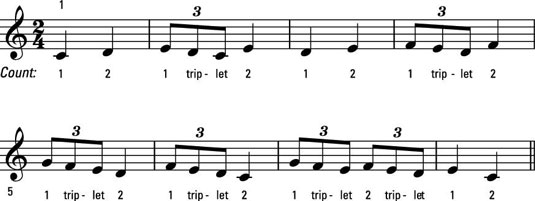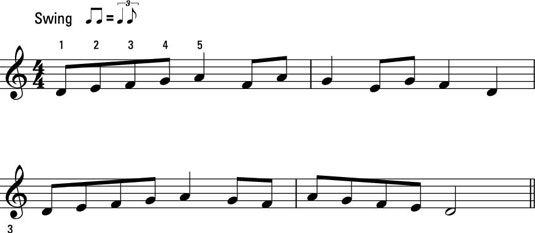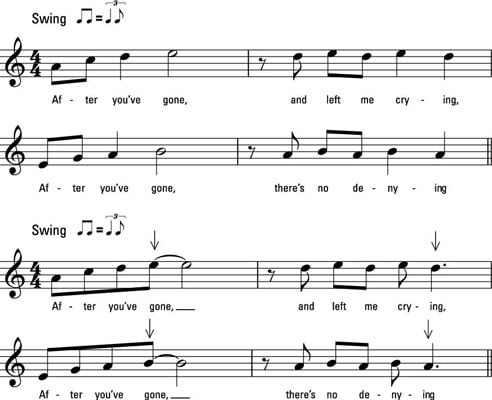When you understand note values and ways to extend those values with ties and dots on the piano, you can expand your rhythmic range with some fancy ways to divide, delay, anticipate, and swing note values. After all, you live in a world filled with rhythm, and most of the music you hear day in and day out is surprisingly rhythmic.
As you check out the following examples, tap your foot along to the examples. Even when you don’t play a note right on the beat, you won’t lose the beat.
Triplets love chocolate
Most notes divide a beat neatly by some factor of two. But every now and then, you may want to divide a beat into more than two eighth notes but less than four sixteenth notes. That means playing three notes per beat, aptly called a triplet.
The most common triplet pattern is the eighth-note triplet, which looks like three beamed eighth notes. To help you spot these triplets quickly, composers add a little number 3 above (or below) the beam. A popular variation on this triplet pattern is the quarter-eighth triplet, which looks like (get this) a quarter note and an eighth note but with a little bracket and a number 3.

You can hear an example of these triplets in Book II, Chapter 5, Audio Track 13 before you try to play them yourself.
To count these triplets, tap your foot and say “1 trip-let, 2 trip-let” or (if you like food metaphors) “choc-o-late” for every beat. The most important point is to divide the beat into three equal parts so each syllable gets its fair share.

Now try playing the triplets. Keep thinking “choc-o-late” until you’ve gotta take a candy bar break.

You can make triplets using other note values, too, but you probably won’t have to play them for a while, at least not until you start jamming with your local drum circle.
It’s worth remembering, though, that with any triplet rhythm, 3 = 2: Three quarter-note triplets equal two quarter notes (two beats), and three sixteenth-note triplets equal two sixteenth notes (half a beat). You play three notes (equally) in the time you would normally play two notes of the same value.
Swing and shuffle time
The beat may go on and on, but music can be quite dull if every note you play is on the beat. By changing up the rhythm a bit and playing some notes off, around, or in between the main beats, your playing takes on a whole new life.
For example: The swing beat. Listen to this swing beat in Book II, Chapter 5, Audio Track 14 while you look at the four measures of music below.

The music track plays the eighth notes with a swing beat. The notes are the same, but the rhythm has a slightly different, swingin’ feel. Instead of straight eighth notes played as “1-and, 2-and,” you hear a long-short, long-short rhythm.
The most accurate way to notate this swing rhythm is with a quarter-eighth triplet. But rather than write a ton of triplets, the composer gives you a big heads up along with the tempo indication above the first measure by telling you to “Swing,” either in plain English or with a little symbol like this one.

When you see the swing notation, you should play all the eighth notes in the music as swing eighths. You can still count them as “1-and, 2-and, 3-and, 4-and,” but the notes on the beats are longer and the notes off the beats are shorter.
The best way to understand the swing beat is to hear it. So popular is this classic American rhythm that it has its own type of bands and dance moves. Listen to some of the music of the big-band era, like the Duke Ellington Orchestra or the Tommy Dorsey Orchestra. They really had the whole world swingin’.
You can always try to play a song with swing eighths right now.
Shuffle feel has the same long-short swing eighths as swing time, but the shuffle beat is more readily associated with rock and blues-style music. A shuffle feel is characterized by a heavier beat than swing, which is lighter on its feet.
Check here to play a song with a shuffle feel.
Syncopation
One of the most common forms of playing off the beat is a little rhythmic concept called syncopation. To understand syncopation, you have to know about downbeats and upbeats. Start tapping your foot to a moderate 4/4 beat, and count eighth notes “1-and, 2-and, 3-and, 4-and.” Your foot goes down on the downbeats and up on the upbeats.
Downbeats are the beats that are normally emphasized in a song. But through the miracle of syncopation, you emphasize some (or all) of the upbeats instead. You play those notes a little bit harder, or louder, than the others. For example, the note normally played on beat 3 is played on the upbeat before, and this anticipation naturally emphasizes the upbeat and creates syncopation.
Here is a two-measure melodic phrase written first to emphasize the downbeat on beat 3, and then transformed into a syncopated rhythm, with the arrows showing the point of emphasis on the upbeat, on “and” before beat 3.

You can hear how syncopation works with a well-known melody. The track plays the opening four measures of the classic song “After You’ve Gone” first without any syncopation, and then with syncopation. Keep your foot tapping the beat throughout the entire eight measures and notice the emphasized notes on the upbeats (when your foot is up). The arrows mark the syncopated notes.


